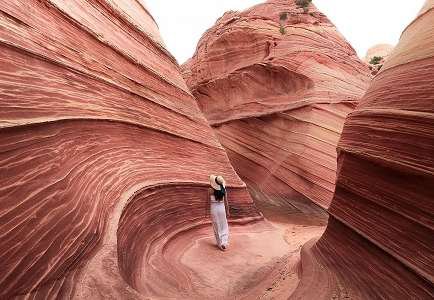The wave is a geological marvel found on the slopes of the Coyote Buttes, at the Arizona-Utah border. It is believed to date back to the Jurassic period during the times prevailing winds pushed the sandy desert dunes across the sandstone, etching it, while water runoff deposited chemicals such as manganese and iron.
The resulting bands of color are referred to as the Liesegang rings, named after a German Chemist. Swirled bands of
color run through the sandstone, ranging from red, pink, orange, yellow, white, and green.
The formation of the Wave began 190 million years ago when dessert dunes compacted and solidified sandstone. The peculiar and unique fluctuating sratum was created by slow wind a
nd rain
y season.
The wave was virtually unknown until the 1990’s when it was widely advertised in German travel brochures, and featured in the 1996 movie Faszination Natur.
In order to protect the rock, only 20 visitors are permitted to access the Wave each day. Permits are issued online through a lottery system where a small permit fee will also
apply.
Despite limited access to protect the landscape, hikers must remain careful as the Wave has edges that will break easily if stepped upon.
Rainstorms can make the road to the Wave impassable. They bring numerous pools which form for several days, containing hundreds of tadpoles and fairy shrimp.
Reaching the Wave involves a 3-mile hike (6-mile roundtrip) across open desert, with no signposted path to follow. A GPS is therefore highly recommended, as it is not unheard of for people to get lost without ever reaching the famous landmark.
The best time of the year to visit the Wave is either during spring or fall, as the weather is neither too hot nor cold. In order to get the best photographs, people tend to visit either during the middle of the day when there are no shadows to be se
en or during
the morning/early evening when stark shadows over the land provide dramatic visuals.




















